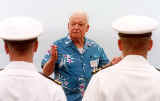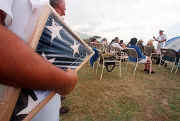By Will Hoover
Advertiser Staff Writer
It’s usually sunny at Keawa‘ula
Beach, but yesterday three dozen friends, relatives and military personnel
sat solemn in the rain to pay tribute to five men involved in a nearly
forgotten tragedy there 50 years ago to the day.
 |
| Former
Navy navigator Robert Lynch recalls how fate kept him off the
flight that killed his crewmates.
Jeff
Widener • The Honolulu Advertiser
|
While people everywhere remember those who fought and died at Pearl Harbor
when America entered World War II, few are familiar with those who fell at
the start of the Korean War, sometimes called "the forgotten
war."
Such an event
occurred on Nov. 27, 1950, at Keawa‘ula,
also known as Yokohama Bay Beach. Shortly after noon, a Navy Patrol
Squadron Four P2V Neptune long-range aircraft stationed at Barber’s
Point was about to embark on a routine training mission off O‘ahu’s
Ka‘ena
Point. Pilot Jess Linn and co-pilot James Clampet were at the controls.
Also aboard were flight engineer Frank Zitkovitch, radioman Malcolm Farris
and ordnance man Harold Neely.
The crew was ready,
the engines were running, and the aircraft, equipped with 16 wing rockets,
had been checked out and given the OK. But because of a scheduling mix-up,
before the plane took off, Clampet received word that he was to relieve
the duty officer.
Junior pilot George
Irelan voluntarily took Clampet’s place. Irelan was excited about flying
with Linn, an experienced pilot who, along with Adm. Richard Byrd, had
charted the Antarctic during Operation Highjump in the 1940s.
No one knows exactly
what happened at 1:21 p.m. Newspaper accounts of the day indicated that
structural damage caused the aircraft to loose its starboard wing. But
many familiar with the crash believe one of the fired rockets
malfunctioned, causing the right wing to tear loose.
What is known is that
on the first target-firing run, the bomber lost its wing, rolled downward
clockwise and disintegrated with a tremendous ball of flame as it crashed
into the ocean.
None of the crew ever
was found. After an extensive week-long search, the men, along with most
of the aircraft, remained part of the sea.
The few human remains
that were found were buried together in one casket in a joint service at
the National Cemetery in Chattanooga, Tenn., on Jan. 19, 1951.
"These things
tend to get forgotten except by those directly involved," said Dave
Hutton, Navy operations officer for the Patrol Force Commander at Kane‘ohe.
"Naval aviation was not as safe a business at that time as it is
today."
 |
| A
casket flag is presented by the family of a former crew member at
a memorial service for five men who died in a plane crash 50 years
ago. Relatives and friends gathered near the crash site, at Ka‘ena
Point.
Jeff
Widener • The Honolulu Advertiser
|
Yesterday’s tribute was organized by Linn’s cousin and O‘ahu
resident Keith Johnson.
Some who hoped to
attend, such as Linn’s brother Bob, couldn’t make it for health and
personal reasons.
"I feel bad
about Jess because he was a friend," recalled original co-pilot
Clampet, who spoke by phone from his home in Oak Harbor, Wash.
"But I feel more
guilty, worse, about Irelan, because I was the guy who asked him if he
wanted to go. He jumped at the chance. Didn’t even change into his
flight suit. Everybody wanted to fly with Jess."
Like Clampet, Robert
Lynch, Linn’s usual navigator, remembers being disappointed about the
last-minute schedule change that day.
"I would have
been on that plane had it not been for the scheduling conflict," said
Lynch, who spoke at yesterday’s tribute.
But on that day,
Lynch received his order change earlier than Clampet, and never boarded
the plane. While Lynch understands Clampet’s feelings, he agrees that
any junior pilot willingly would have flown with Linn.
"A Jess Linn
doesn’t come along very often," said Lynch, who explained that Linn
was generous about letting co-pilots fly the plane and fire rockets.
"He would share the flight time, which was somewhat unusual. He was a
good instructor. He gave us a chance."
Irelan’s older
brother, Richard, also spoke briefly to those gathered at on the beach.
"I remember that
day ·" he started out, and then became too choked up to continue.
"It’s very difficult for me to talk about. My brother and I were
close."
Irelan presented the
casket flag that was used in the joint services in Chattanooga to the
Navy. That flag will be be displayed at the Commander Patrol and
Reconnaissance Force, U.S. Pacific Fleet Headquarters in Kane‘ohe.
Although the occasion
yesterday was wet, the spirits of those present were not dampened.
"I thought it
was wonderful," said a soaked but smiling Judy Jones, Linn’s niece.
At the end of the
ceremony a Navy plane from Patrol Squadron 4, stationed these days at Kane‘ohe,
flew over and dropped a marker on the exact location of the crash, about
two miles off the beach at Ka‘ena
Point.
[back to
top]
|